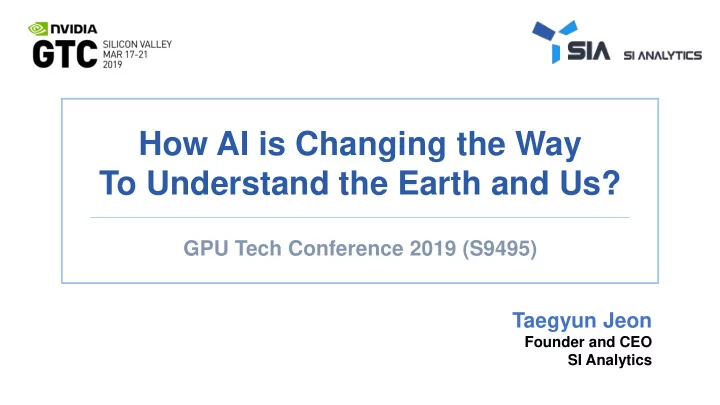

How AI is Changing the Way To Understand the Earth and Us? GPU Tech Conference 2019 (S9495) Taegyun Jeon Founder and CEO SI Analytics
Contents • Earth Observation with Artificial Intelligence • Case #1: Object Detection and Classification with TensorRT • Case #2: Road Extraction (DeepGlobe Challenge) • Conclusions
01 Earth Observation
Earth Observation ✓ defense & Intelligence ✓ infrastructure monitoring ✓ forecasting weather ✓ biodiversity and wildlife trends ✓ land-use change ✓ natural disasters ✓ natural resources ✓ agriculture ✓ emerging diseases ✓ mitigating climate change ✓ maritime monitoring
KITSAT-1 (1992) KITSAT-2 (1993) KITSAT-3 (1999) GSD: 400m GSD: 200m GSD: 13m
KOMPSAT-3A (2015) GSD: 0.55m
This image of New York City, taken Nov. 4, 2015, by South Korea's Kompsat-3A satellite, is an example of the products that SI Imaging Services of Korea has begun selling on the market.
Earth Observation with Artificial Intelligence Traditional EO EO with AI On-demand data On-demand analysis Reactive tasking based on single satellites Reactive tasking based on constellations ORDERING Data cost is driven by the data source (higher CAPEX system equates to higher data prices); lower-cost systems would imply lower data prices and services development Owned data analysis Cloud approach + Owned data analysis PROCESSING Manual/automated operations Deep Learning based on Big Data on desktop or internal network Ad hoc services, ordering Service subscription basis through reseller or web-portal tasking DELIVERING Reselling network, privileged distributors Platform deliveries (private sector focused) (government user focused) and reselling network for governments 9
Coverage South Korea (100,210 km 2 ) England (243,610 km 2 ) KOMPSAT-2 Coverage KOMPSAT Archive KOMPSAT-2 (EO) KOMPSAT-3 (EO) KOMPSAT-3A (EO) KOMPSAT-5 (SAR) Scenes 2,645,022 781,389 80,340 52,245 (Dec 15, 2016) Data volume USA 743 TB 700 TB 59 TB 104 TB (TB) (9,834,000 km 2 ) Coverage per day (km 2 ) 1,700,000 300,000 240,000 Up to 1,000,000
Volume 0.7KB 150KB 87MB SpaceNet MNIST ImageNet (3K,3K,8) (28,28,1) (224,224,3) 2.5GB Satellite Scene (25K, 25K, 4)
Resolution (DigitalGlobe) WorldView-4 ~0.3m resolution $835M++ (Satrec Initiative) SpaceEye-X ~0.5m resolution $60M
Reusable rocket and Constellation space program ✓ Low launch cost ✓ Low manufacturing cost ✓ Huge daily data
Object Detection and 02 Classification
Detection and Classification • Aircraft Detection & Classification ▪ Task: Detect and classify all aircraft on North Korea Airforce bases ▪ Construct Own Dataset for civil aircraft and military fighters ▪ Compatibility: Transfer Learning Detection Results (Haneda Airport from KOMPSAT-2, 3, 3A) Detection and Classification (NK Airforce bases from GoogleEarth) (GoogleEarth & KOMPSAT 2, 3, 3A) Prob. (Detection) ▪ Detection Accuracy : 89% Magnified view ▪ Classification Accuracy : 95.2% Prob. (Classification) ▪ Target Area : All NK Airforce bases ▪ Fill the gap for rare observation: Combine synthetic data from GAN Automatically generated deployment status report (NK Airforce) User Interface for Detection and Classification 15
Detection and Classification • Objective : Detect aircraft and fighter, then classify the types of aircraft Overlap: 16
North Korean Air Forces (25 regions) 17
Detection Results • ROI: 25 Airports (North Korea) • Detection results: Precision (0.84), Recall (0.79), F1 (0.82) • Classification results: Top-1 (91.5%), Top-3 (95.4%) 18 S. Jeon, J. Seo and T. Jeon, “Multi -task Learning for Fine- grained Visual Classification of Aircraft” , MLAIP Workshop @ ACML (2017)
Classification with TensorRT 1.6X 1000 880.35 900 800 700 600 525.57 Image/s 500 2.2X 400 300 200 83.5 100 37.74 0 DenseNet (512,512,3) VGG (128,128,3) w/o TRT w/ TRT * Experiments on DGX-Station
Probability (Detection) Magnified view Probability (Classification) 20
21 2
22
Synthetic Data Generator and Refiner J. Seo, S. Jeon and T. Jeon, “ Domain Adaptive Generation of Aircraft on Satellite Imagery via Simulated and Unsupervised Learning ” , MLAIP Workshop @ ACML (2017) Adversarial Learning to refine the synthetic images from reference images 23
Synthetic Data Generator and Refiner Qualitative and Quantitative Evaluation 24
Summary • Task: Detect and classify all aircraft on North Korea Airforce bases • Construct Own Dataset for civil aircraft and military fighters • Compatibility: Transfer Learning between GoogleEarth and KOMPSAT 2, 3, 3A • TensorRT : Speed-up to 2.2X (DenseNet) and 1.6X (VGG). • Fill the gap for rare observation: Combine synthetic data from GAN 25
03 Road Extraction
Road Extraction • Automatic Mapping from Image to Road • Usages ▪ Automated Map Update ▪ Urban Planning ▪ City Monitoring ▪ Road Navigation ▪ Operation of Unmanned Vehicles ▪ Attention of Safety Road
DeepGlobe Challenge (CVPR 2018)
Challenges of Road Extraction • Wide-area Processing • Noisy Labeling & Ambiguity • Extraction of Road Network Topology • Model Efficiency • Intrinsic Noise of Road Image
D-LinkNet: 1 st Winner of the 2018 Challenge
D-LinkNet: 1 st Winner of the 2018 Challenge
Our Motivation Non-Local Operations
Non-Local LinkNet (NL-LinkNet) N on- L ocal B lock ( NLB ) Overall Architecture
Quantitative Comparison
Visual Comparison
Model Efficiency
Summary • Core Idea: Non-local Operations • Non-Local Block is better than traditional convolutional ops.
04 Conclusions
Conclusions • Object Detection and Classification: Use case for Defense • TensorRT: Speed-up to 2.2X (DenseNet) and 1.6X (VGG). • Fill the gap for rare observation: Combine synthetic data from GAN • Non-Local Block : Extraction of Road Network Topology
Thank you for attention! SI Analytics Co., Ltd. (Satrec Initiative Group) 441Expo-ro, Yuseong-gu, Daejeon, 34051, Korea tgjeon@si-analytics.ai www.si-analytics.ai
Recommend
More recommend